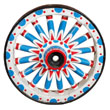Originally known as St. George and the Dragon Telescoping Tableau
by Richard E. Conover
Unlike the Five Graces, no controversy has arisen over the suitability of the names that have been associated with this wagon. In its original configuration the top-mounted figure of St. George in the act of slaying the fabled dragon well described its predominate theme, while its latter-day name of the Lion & Mirror Bandwagon accurately reflects all that this generation has ever seen of it. The earliest references that I have found of this Forepaugh parade wagon date no farther back than 1881. It was originally a true telescoper similiar to the 1871 Howes Great London Circus examples.
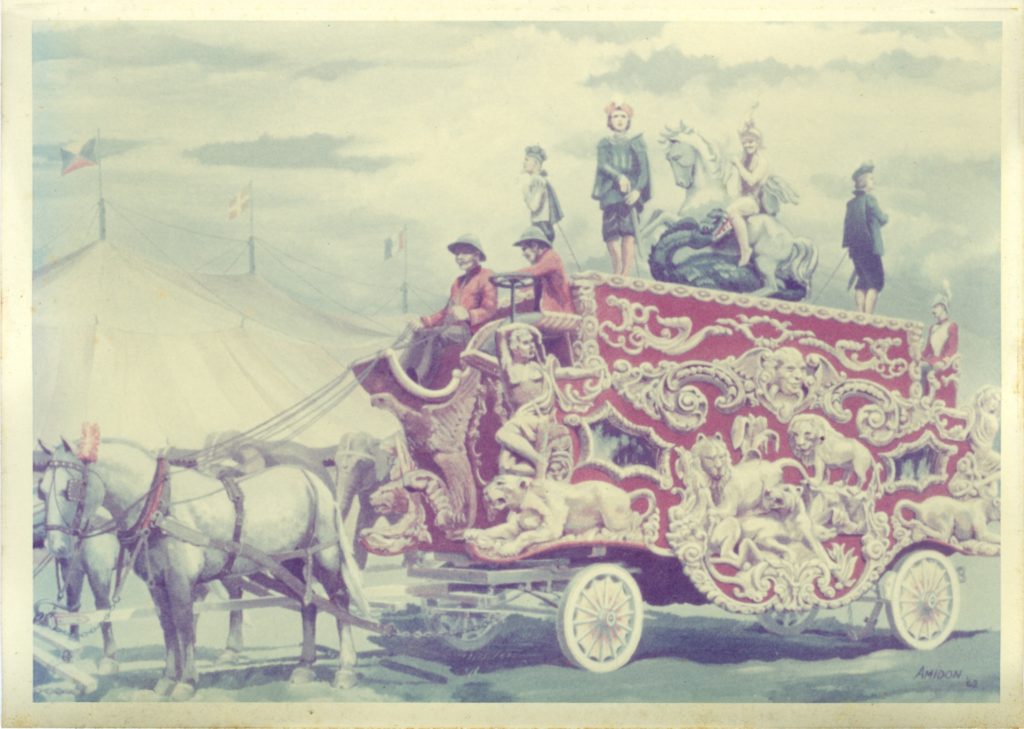 ( A beautiful artist’s rendition – Richard Conover collection )
( A beautiful artist’s rendition – Richard Conover collection )
In my 1956 pamphlet, The Telescoping Tableaus, I introduced some non-conclusive evidence (that will be updated herein) which strongly indicated that this tableau was imported from England. Nothing really substantial from which to further resolve this facet of its history has been added to the information that was at hand in 1956. We can only speculate now, since it has been resolved that the Five Graces did not have a telescoping mechanism and since the Graces was the only one of the four towering tableaus definitely known to have been made in the States, the likelihood of the St. George coming from the same foreign source that built the 1871 Howes tableaus is a bit more plausible. Living on this side of the Atlantic, it is virtually impossible to get any further leads because none of my British contemporaries have any knowledge whatsoever in their long-gone parade wagons or the manufacturers thereof, nor do they know of a single authority on the subject. It would even help to know if the limeys of the last century were accustomed to seeking gastromomic relief from Hostetter’s Celebrated Stomach Bitters or if this engraving, which obviously was the inspiration for the theme figure of this tableau, was used to pitch some other product in their domain. Here in America it had been doing it since as early as 1863. There has, however, been one additional minor item turn up since 1956 that gives some, although weak, support to the old evidence. This is from a review of the Ringling parade in the Columbus, Ohio, Dispatch of 11 September 1893 which read: “- their bandwagon is of English manufacture – ” referring, of course, to the Lion & Mirror which at that time was Ringling’s lead bandwagon. It would only be a little less logical to dismiss this as pure propaganda.
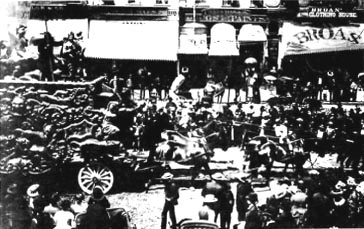
( 1887 – Richard Conover collection )
The only available photograph of the St. George Tableau in its original configuration, one of a set of three logically important ones for the immediate purpose, was made in Lansing, Michigan, on 28 May 1887. A second photograph in this set shows the Five Graces after its top-mounted globe-lion group had been removed and the third of the set is of this same globe-lion group on its first set of running gears. While this Lansing picture is the earliest one of the Five Graces that we have, it has been omitted because, besides being photographically inferior to others, it is believed that its logical importance can be adequately introduced without displaying the actual photograph.
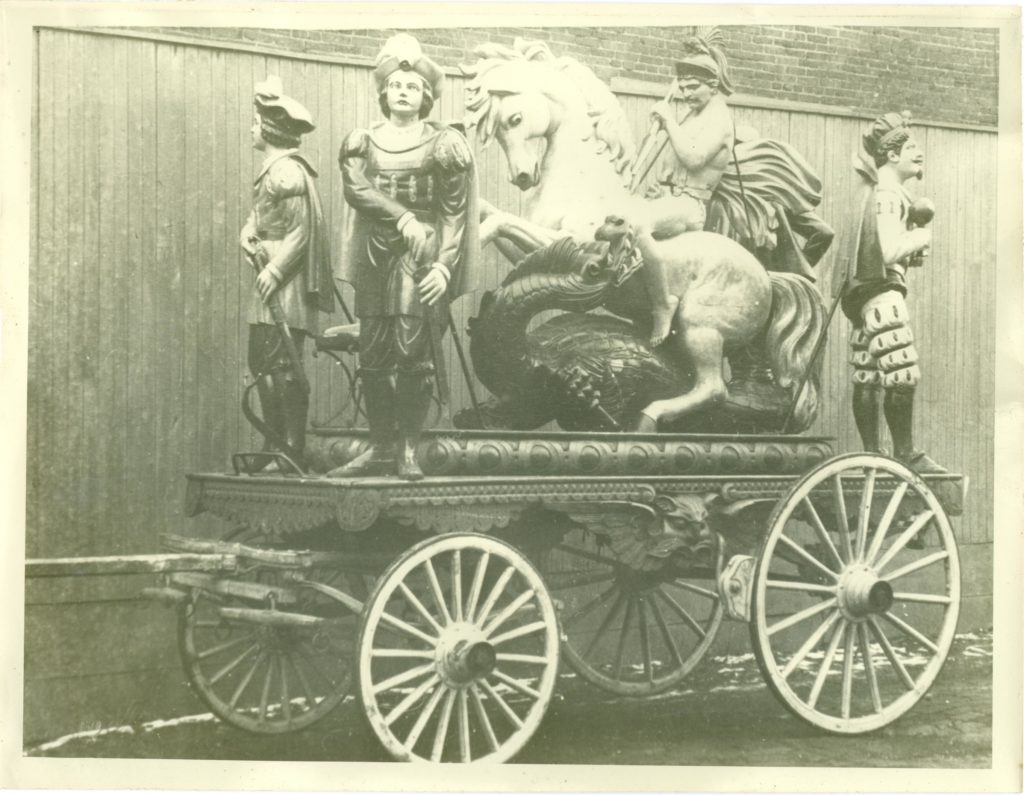 ( Richard Conover collection )
( Richard Conover collection )
Sometime between the 1887 date of the Lansing pictures and the fall of 1890 another set of significant pictures were made at the Forepaugh winterquarters in Philadelphia. One of the set is of a small float carrying what had been the top and theme figure of the St. George Tableau in the 1887 picture. The upper limit of the 1887-1890 allowable span of years in which this top could have been removed can be set by three items that appeared in the Clipper in the fall of 1890, the date that fixes the sale of the main body, the St. George Float, and another tableau to the Ringlings. The earliest of these Clipper items is also our best evidence to support the possibility of its foreign origin; it being a Forepaugh advertisement that appeared on 22 November 1890. The second item was another ad that was run on the 27th of December. Examination of the fine print in these sale offerings will reveal that the “2 Big English Chariots, one suitable for a bandwagon” appeared only in the 22nd of November insertion. This coupled with a news item in the December 20 issue, which placed John and Otto Ringling at the Forepaugh quarters in Philadelphia, recently, where they acquired several chariots, accounts for the ommission of these items from the second advertisement.
A long-standing tradition, crediting the Moeller Brothers with rebuilding the St. George into the Lion & Mirror Bandwagon, can now be explored as being 99% myth. This story, generic from the late Henry Moeller, has been that the St. George arrived intact in Baraboo in 1890 and that it was the Moellers who dismantled it, set the St. George figure on its separate platform-gear, performed the necessary modifications to the main body to convert it to the bandwagon, and built another float (unidentified) out of the parts surrounding the rectangular well through which the telescoping figure had operated. Since 1956 two more photographs, definitely know to be Ringling in the 1890’s, have been made available. One of these is of the St. George Float on exactly the same gear that it was on in the Philadelphia picture. The other is one of the best of several available showing the rectangular well still in place on the Lion & Mirror. Actually, the railing for this former well was still in place until shortly before 1900; so other than possibly decking in the opening it is certainly not apparent just what this “major” Moeller conversion job could have amounted to. Still it will always be pleasant to remember the convincing twinkle in Henry Moeller’s eye when he told the story. That is the way he was living the event so many, many years later.
Pictures of the St. George Float in Ringling parades seem to be practically non-existent. Either from route books or from newspaper accounts its presence there can be traced through 1896. Between then and 1900 when we begin to get substantial photographic coverage of the Ringling parade there is almost a void of any information. So far the St. George has not appeared in any vintage 1900 photographs, and since by then there were several new floats in evidence, it can be surmised that it had been retired. In 1913 it, plus two tableaus and two cages from the 1912 surplus list, were sold to J. H. Garrett for his second try at Rice Brothers. That attempt lasted for most of the season but for the next year and a half its chattels were shuttled about the country while Garrett and W. E. Franklin (erstwhile general agent, partner in King & Franklin, John Robinson & Franklin Brothers, etc.) who held the mortgage fought it out in the courts. Franklin finally won out and in September 1915 sold all that had not been stolen off to the Wortham Carnival. Only two fragments of this property have ever turned up in subsequent pictures; one of the cages that was purchased from Ringling that dates back to the Forepaugh-Sells turns up on Mugivan and Bowers’ Howes Great London and an old Campbell Brothers cage was still at the Wortham quarters in San Antonio in the 1920’s. The trail of the St. George Float, at the moment, is still cold.
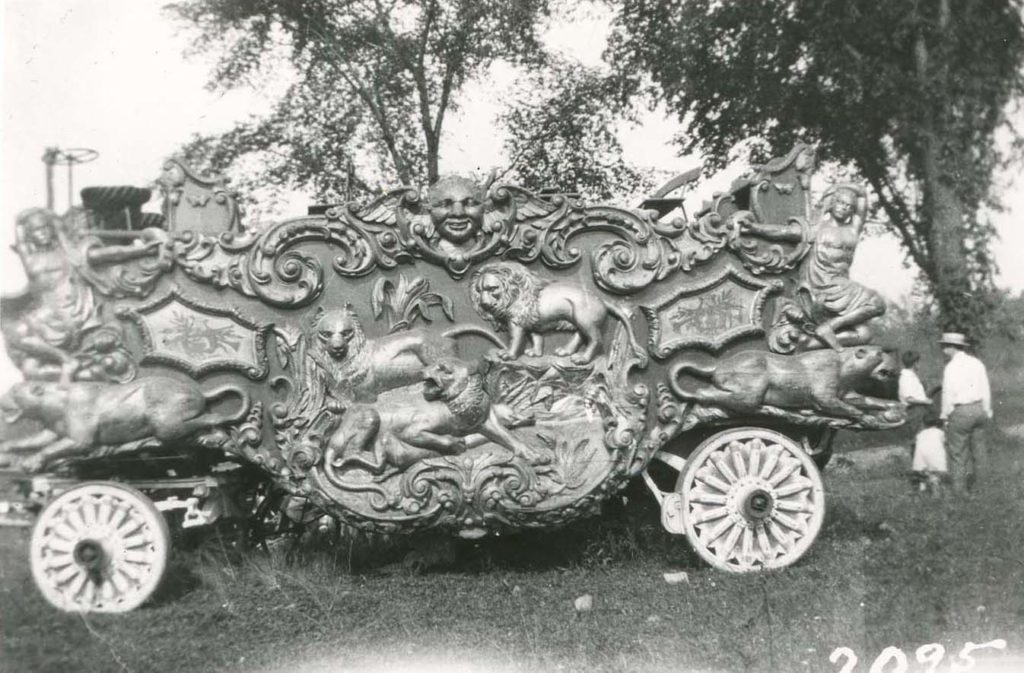 ( Undated photo shows the dark wagon body – Joseph Bradbury Album # 6 – photo # 36B – Christy Bros. Circus )
( Undated photo shows the dark wagon body – Joseph Bradbury Album # 6 – photo # 36B – Christy Bros. Circus )
From 1891 and until 1905, when the new Swan Bandwagon with its twenty-four horse hitch was brought on, the Lion & Mirror was the Ringling No. 1 Bandwagon; after which it became the second or sometimes the side show bandwagon. In January 1915 it was in the Moeller shops for its yearly repair work for the last time, the year corresponding with its last mention the parade list. At this juncture it joined the Swan Bandwagon in the storage shed, which as mentioned before had been there since 1912. There they remained until George Christy bought them on 14 November 1925. In this purchase Christy acquired the two bandwagons, two unidentified cages, and three of the allegorical pony floats for $4,000. Christy did not route his show to Baraboo until 30 May 1927 when he picked up both the bandwagons, and one or both the cages. He did not get the pony floats because, meanwhile, Fred Buchanan had been there, bribed the attendant of the abandoned quarters for the key, stole the floats, and attached them to his Robbins Brothers Circus. George Christy’s revelations about this incident sure clears up the unlogical tradition that Buchanan acquired these floats from Bridgeport because it has been unlogical for them to have been there since they did not leave Baraboo with the Ringling train in 1918.
The last year for the Christy Brothers Circus was 1930. George Christy retained all of the property at his Houston, Texas, quarters until late in 1934 when he sold a parcel, including the Lion & Mirror, to the newly organizing Cole Brothers Circus with headquarters at Rochester, Indiana. Cole Bros. used it in 1935 and 1936. It still had the three dimensional armament on the mirrors that had been there since the Christy Bros. days.
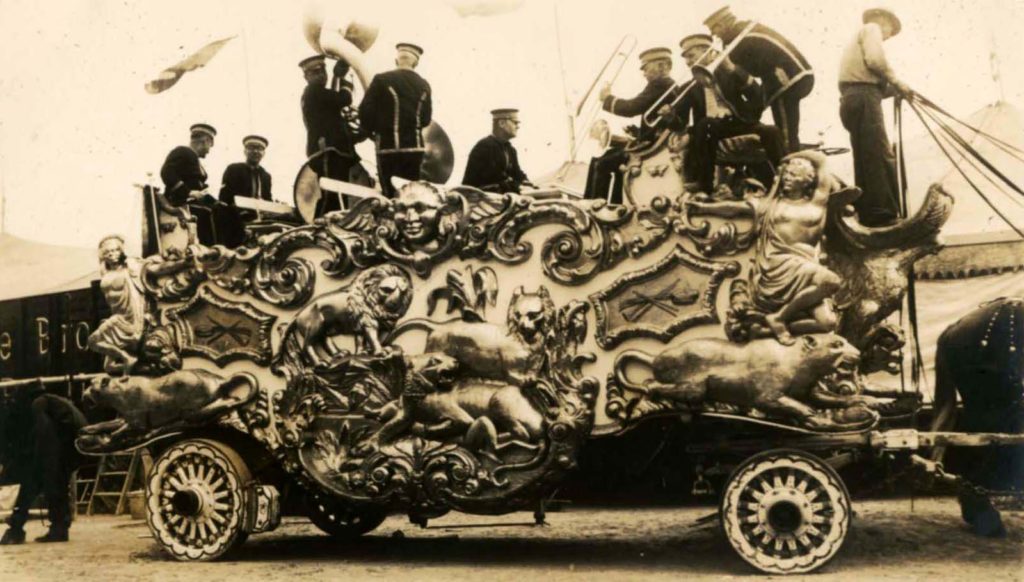 ( 1935 – Bob Good photo )
( 1935 – Bob Good photo )
In 1937, the armament fixtures were removed from the mirrors and the mirrors were painted like a flag. Those flag painted mirrors, would remain on this wagon while sitting in a storage shed and later in the fields of the Rochester winter quarters.
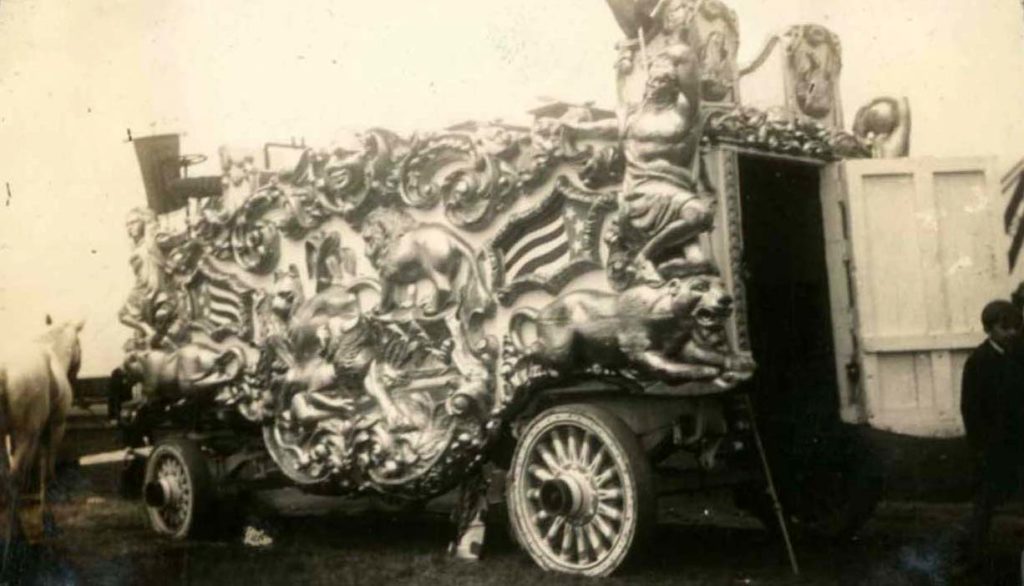
( July 14, 1937 in Benton Harbor, MI. – Gordon Potter photo )
By early 1946 it had been moved to a farm near Rochester where it was left outside exposed to the elements. That would have been the finish of it if the Block & Kuhl Department Store of Peoria, Illinois had not acquired and restored it for use in their annual Thanksgiving Day parades. After the 1961 parade it was presented to the Circus World Museum in Baraboo, Wisconsin.
In the years of being at the Circus World Museum, the wagon has been painted on three occasions. The wagon was white with gold carvings for most of its show business career. That was the way it was when given to the Circus World Museum and this stellar postcard was created.
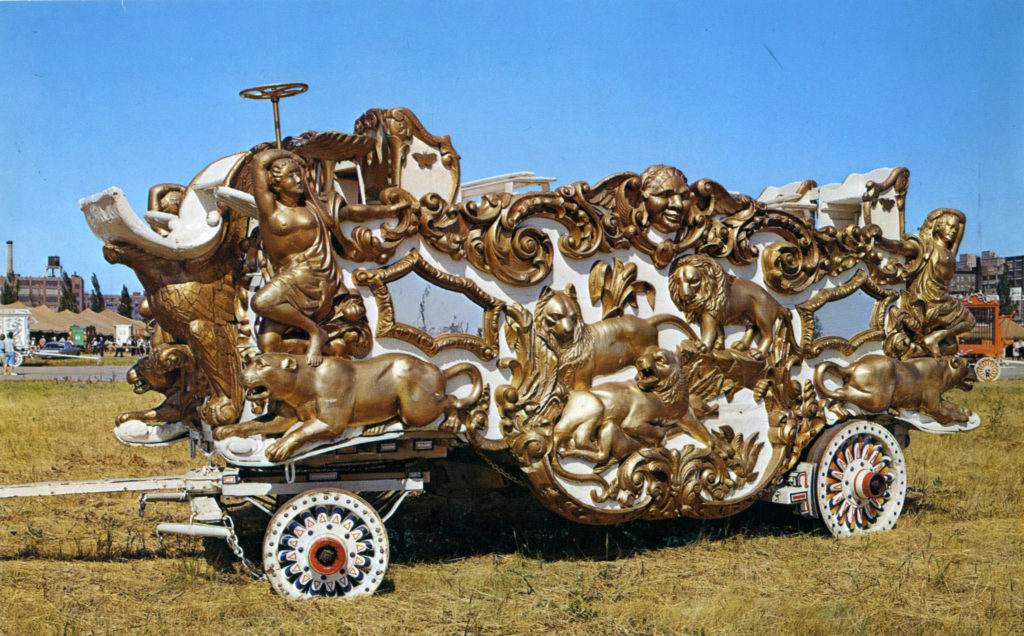 ( CWM Postcard )
( CWM Postcard )
Shortly after arriving at the Circus World Museum, the wagon was re-painted with a green body and gold carvings.
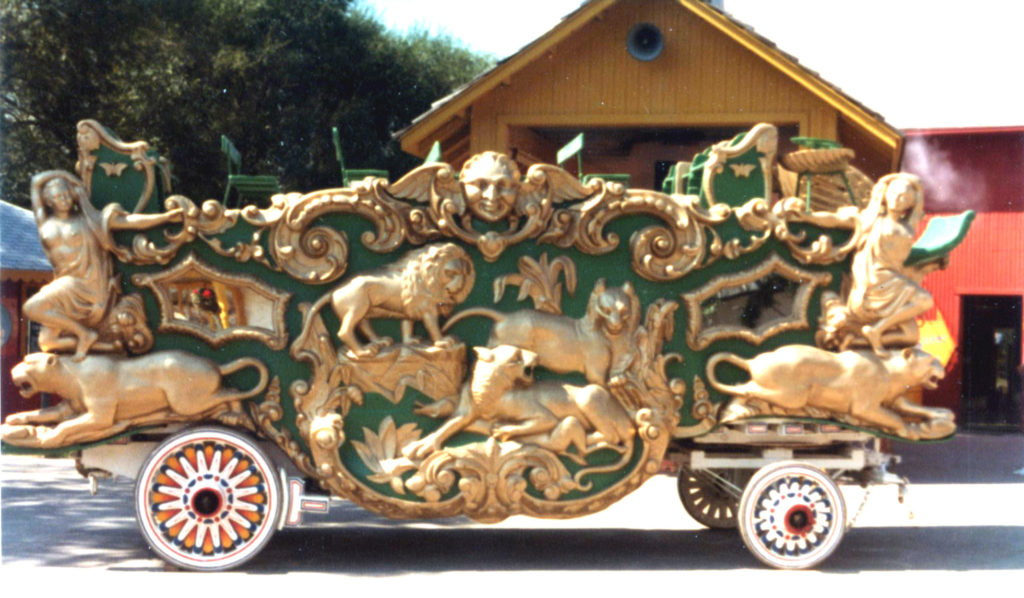
( Richard Cline photo )
The Last time this wagon was re-painted, the body was painted red with a beautiful gold leaf applied to the carvings.
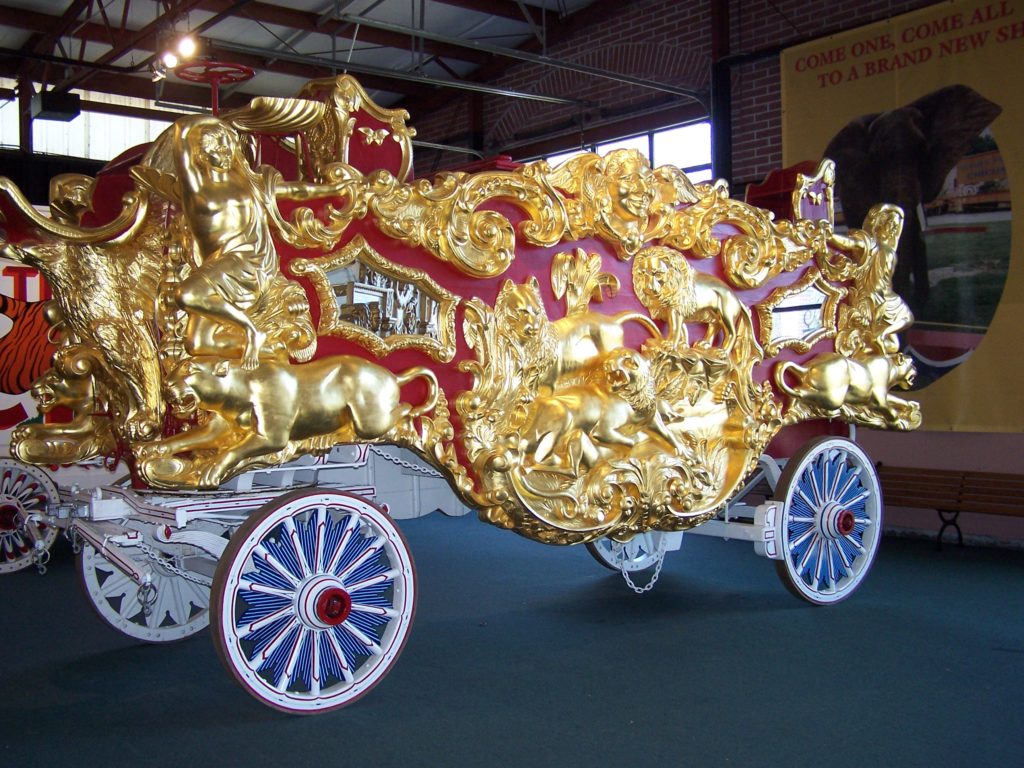 ( 2006 – Bob Cline photo )
( 2006 – Bob Cline photo )
(1) Bandwagon, Vol. 15, No. 6 (Nov-Dec), 1971, pp. 13-15
The wagon can be seen in person at Circus World in Baraboo, Wisconsin
If you have any questions or have more photographic evidence, feel free to contact us at circuswagons@gmail.com
